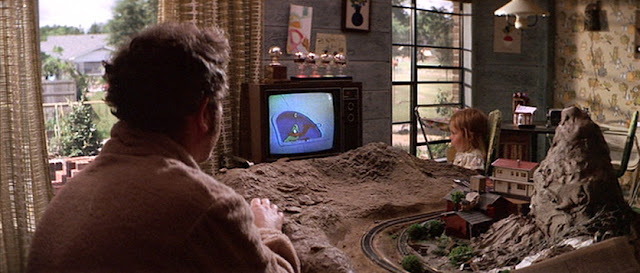Not surprisingly for a charter member of the Film School Generation of directors, Steven Spielberg has always been a savvy user of movie-in-movies. We’ve already considered E.T. the Extra-Terrestrial, Jurassic Park, and Minority Report. This post and the next will look at a few more Spielbergs, in chronological order.
His first feature film, in 1974, was The Sugarland Express, with Goldie Hawn and William Atherton, a low-speed chase movie based on the true story of of a real-life Texas couple who took a cop hostage in their quest to wrest back their toddler from his adoptive parents. It has a real ’70s vibe, with its improv-seeming scenes, use of non-actors, and sense of the American roadscape that’s at once loving and ironic. The last is enhanced by Vilmos Zsigmond’s cinematography, often grainy because of long shots showing an endless trail of police cars. The movie is of a piece with contemporaneous character-centered slices of Americana like Terence Malick’s Badlands, Robert Altman’s Thieves Like Us, and Lamont Johnson’s The Last American Hero.
Spielberg, of course, would quickly pivot to a very different approach, but this movie works best in its small moments (the periodic car wrecks are tiresome), including the movie-in-movie sequence. Hawn and Atherton are hiding out in an RV that’s in a used-car lot overlooking a drive-in-movie. (Talk about the American roadscape!) We only briefly see the film that’s playing, but reliable sources assert that it’s Sssssss (1973), whose premise an IMDB contributor summarizes as: “A college student becomes lab assistant to a scientist who is working on a serum that can transform humans into snakes.”

Sssssss has nothing to do, on any level, with The Sugarland Express, and I’m pretty sure the only reason it was used is that — like Sugarland — it was produced by Richard Zanuck and David Brown and released by Universal, and hence cost little or nothing.
The more pointed movie-in-movie is a cartoon that subsequently comes on at the drive-in, the Road Runner short “Whoa, Be Gone!” (1958), directed by Chuck Jones. (This is the third time I’ve noted Jones being used in feature films, the others being The Shining and the Spielberg-produced Gremlins.) “Hey, we got a free movie next door!” says Hawn’s character:
Improbably, Spielberg makes the Road Runner and Wile E. Coyote’s antics into a tender moment, and foreshadowing of what lies in store for the young couple.
Spielberg followed up Sugarland Express with Jaws (no movies-in-movie) and, in 1977, Close Encounters of the Third Kind, which is marked by quite a few — and quite varied — inserts. IMDB claims that a Road Runner clip is shown on a TV, but I confess I wasn’t able to spot it. It’s impossible, however, to miss another Chuck Jones short, the classic “Duck Dodgers in the 24 1/2 Century” (1953), which is on TV as Roy Neary (Richard Dreyfuss) obsessively labors on a his model of a landscape that’s really important, he doesn’t know exactly why. The contrast, of course, is between Jones’s wacky version of spacemen and Roy’s (implicitly) real ones.

In a couple of other moments, the urgency of the scenario is contrasted with the banality of ‘ the 70s TV shows that are playing in the background: Policewoman in one scene, The Days of Our Lives in another.
The tastiest meta set piece is a scene where Roy’s at home with his wife (Teri Garr) and three kids. He gets temporarily distracted from his UFO obsession by the fact that Pinocchio — for some reason one of his favorite movies — is playing at a local theater. The Disney reference isn’t the only one in Spielberg: Gremlins features Snow White and in the next post, you’ll see what’s in 1941. It’s (to me) an odd enthusiasm — I much prefer the madcap and antic Chuck Jones — and I’m with the kids, who vote to play miniature golf instead.
The focus then shifts to Cecil DeMille’s The Ten Commandments (1956), which is playing on TV. Everybody except Garr is transfixed by it: the kids for unknown reasons, and Roy because Mt. Sinai resembles, of all things, the landscape that’s haunting his consciousness.
Next: 1941, Catch Me If You Can, and Munich.

Pingback: Spielberg Roundup, II: ‘Dumbo’ in ‘1941’; ‘Goldfinger’ in ‘Catch Me If You Can’; ‘The Man Who Shot Liberty Valance’ in ‘Munich’ – Movies in Other Movies